
Arthur St. Clair was a Scottish-American soldier and politician. Born in Thurso, Scotland, he served in the British Army during the French and Indian War before settling in Pennsylvania, where he held local office. During the American Revolutionary War, he rose to the rank of major general in the Continental Army, but lost his command after a controversial retreat from Fort Ticonderoga.

Little Turtle was a Sagamore (chief) of the Miami people, who became one of the most famous Native American military leaders. Historian Wiley Sword calls him "perhaps the most capable Indian leader then in the Northwest Territory," although he later signed several treaties ceding land, which caused him to lose his leader status during the battles which became a prelude to the War of 1812. In the 1790s, Mihšihkinaahkwa led a confederation of native warriors to several major victories against U.S. forces in the Northwest Indian Wars, sometimes called "Little Turtle's War", particularly St. Clair's defeat in 1791, wherein the confederation defeated General Arthur St. Clair, who lost 900 men in the most decisive loss by the U.S. Army against Native American forces.

Greenville is a city in and the county seat of Darke County, Ohio, United States, located near the western edge of Ohio about 33 miles northwest of Dayton. The population was 13,227 at the 2010 census.

The Northwest Territory, also known as the Old Northwest and formally known as the Territory Northwest of the River Ohio, was formed from unorganized western territory of the United States after the American Revolutionary War. Established in 1787 by the Congress of the Confederation through the Northwest Ordinance, it was the nation's first post-colonial organized incorporated territory.

The Battle of Fallen Timbers was the final battle of the Northwest Indian War, a struggle between Native American tribes affiliated with the Western Confederacy and their British allies, against the nascent United States for control of the Northwest Territory. The battle took place amid trees toppled by a tornado near the Maumee River in northwestern Ohio at the site of the present-day city of Maumee, Ohio.

Jean-François Hamtramck (1756–1803) was a French Canadian who served as an officer in the US Army during the American Revolutionary War and the Northwest Indian War. In the Revolution, he participated in the Invasion of Quebec, the Sullivan Expedition, and the Siege of Yorktown. In the history of United States expansion into the Northwest Territory, Hamtramck is connected to 18th century forts at modern Midwest cities such as Steubenville, Vincennes, Fort Wayne, and Detroit. The town of Hamtramck, Michigan is named for him.
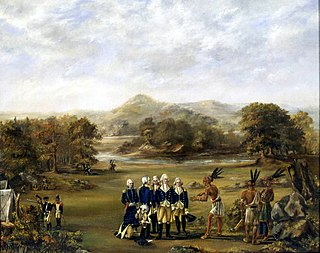
The Northwest Indian War (1785–1795), also known as the Ohio War, Little Turtle's War, and by other names, was a war between the United States and the Northwestern Confederacy, with support from the British, for control of the Northwest Territory. It followed centuries of conflict over this territory, first among Native American tribes, and then with the added shifting alliances among the tribes and the European powers of France and Great Britain, and their colonials. The United States Army considers it their first of the United States Indian Wars.
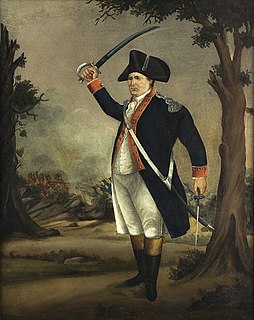
William Darke was an American soldier who served with British forces before the Revolutionary War. He served with British regulars commanded by Major General Edward Braddock in his 1755 expedition to the French-controlled Ohio Valley, as part of the French and Indian War. The British forces were defeated and Braddock died.

The Western theater of the American Revolutionary War (1775–1783) was the area of conflict west of the Appalachian Mountains, the region which became the Northwest Territory of the United States as well as the states of Kentucky, Tennessee, Missouri and Spanish Louisiana. The western war was fought between American Indians with their British allies in Detroit, and American settlers south and east of the Ohio River, and also the Spanish as allies of the latter.

William Wells, also known as Apekonit, was the son-in-law of Chief Little Turtle of the Miami. He fought for the Miami in the Northwest Indian War. During the course of that war, he became a United States Army officer, and also served in the War of 1812.
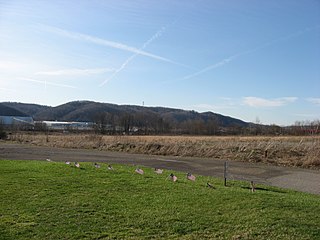
Legionville was the first formal basic training facility for the military of the United States. The camp, which was established in winter 1792 under the command of Major General Anthony Wayne, was near present-day Baden, Pennsylvania, a suburb of Pittsburgh. It was used to train the soldiers which would become the Legion of the United States.

Fort Recovery was a United States Army fort ordered built by General "Mad" Anthony Wayne during what is now termed the Northwest Indian War. Constructed from late 1793 and completed in March 1794, the fort was built along the Wabash River, within two miles of what became the Ohio state border with Indiana. A detachment of Wayne's Legion of the United States held off an attack from combined Indian forces on June 30, 1794. The fort was used as a reference in drawing treaty lines for the 1795 Treaty of Greenville, and for later settlement. The fort was abandoned in 1796.

The Legion of the United States was a reorganization and extension of the Continental Army from 1792 to 1796 under the command of Major General Anthony Wayne. It represented a political shift in the new United States, which had recently adopted the United States Constitution. The new Congressional and Executive branches authorized a standing army composed of professional soldiers, rather than relying on state militias.

Fort Washington was a fortified stockade with blockhouses built by order of Gen. Josiah Harmar starting in summer 1789 in what is now downtown Cincinnati, Ohio near the Ohio River. The physical location of the fort was facing the mouth of the Licking River, above present day Fort Washington Way. The fort was named in honor of President George Washington. The Fort was the major staging place and conduit for settlers, troops and supplies during the settlement of the Northwest Territory.

The Siege of Fort Recovery, 30 June – 1 July 1794, was a battle of the Northwest Indian War, fought at the present-day village of Fort Recovery, Ohio. A large force of warriors in the Western Confederacy attacked a fort held by United States soldiers deep in Ohio Country. The United States suffered heavy losses, but maintained control of the fort. The battle exposed a division in the Western Confederacy's military strategy at a time when they seemed to hold the advantage, and the United States pressed farther into the Northwest Territory.

The First American Regiment was the first peacetime regular army infantry unit authorized by the Continental Congress after the American Revolutionary War. Organized in August 1784, it served primarily on the early American frontier beyond the Appalachian Mountains. In 1815, following the end of the War of 1812, it was consolidated with several other regiments to form the 3rd Infantry Regiment.

The Harmar campaign was an Autumn 1790 attempt by the United States to subdue Native Americans nations in the Northwest Territory that were seen as hostile. The campaign was led by General Josiah Harmar, and is considered a significant campaign of the Northwest Indian War. The campaign ended with a series of battles from 19–21 October 1790 near the Miami villages of Kekionga. These were all overwhelming victories for the Native Americans, and are sometimes collectively referred to as Harmar's Defeat.

St. Clair's defeat, also known as the Battle of the Wabash, the Battle of Wabash River or the Battle of a Thousand Slain, was a battle fought on 4 November 1791 in the Northwest Territory of the United States of America. The U.S. Army faced the Western Confederacy of Native Americans, as part of the Northwest Indian War. It was "the most decisive defeat in the history of the American military" and its largest defeat ever by Native Americans.
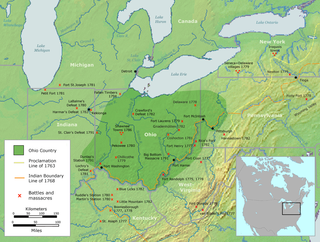
The siege of Dunlap's Station was a battle that took place on January 10–11, 1791, during the Northwest Indian War between the Western Confederacy of American Indians and European-American settlers in what became the southwestern region of the U.S. state of Ohio. This was one of the Indians' few unsuccessful attacks during this period. It was shortly after the Harmar Campaign attacks and unprecedented defeat of U.S. Army forces. A few months after the siege, the United States Army suffered a major defeat at the hands of the Indians.
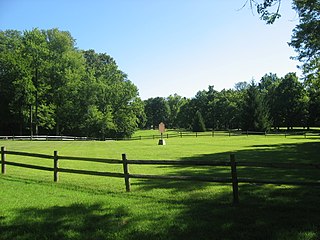
Fort St. Clair was a fort built during the Northwest Indian War near the modern town of Eaton, Preble County, Ohio. The site of the fort was listed on the National Register of Historic Places in 1970.






















